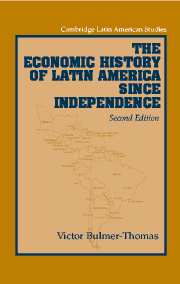Book contents
- Frontmatter
- Contents
- List of tables, figures, and maps
- Preface to the second edition
- Preface
- List of abbreviations
- 1 Latin American economic development: an overview
- 2 The struggle for national identity from independence to midcentury
- 3 The export sector and the world economy, circa 1850–1914
- 4 Export-led growth: the supply side
- 5 Export-led growth and the nonexport economy
- 6 The First World War and its aftermath
- 7 Policy, performance, and structural change in the 1930s
- 8 War and the new international economic order
- 9 Inward-looking development in the postwar period
- 10 New trade strategies and debt-led growth
- 11 Debt, adjustment, and the shift to a new paradigm
- 12 Conclusions
- Appendix 1 Data sources for population and exports before 1914
- Appendix 2 The ratio of exports to gross domestic product, the purchasing power of exports, and the volume of exports, circa 1850 to circa 1912
- Appendix 3 Gross domestic product per head, 1913, 1928, 1980, and 2000
- Bibliography
- Index
- CAMBRIDGE LATIN AMERICAN STUDIES
9 - Inward-looking development in the postwar period
Published online by Cambridge University Press: 05 June 2012
- Frontmatter
- Contents
- List of tables, figures, and maps
- Preface to the second edition
- Preface
- List of abbreviations
- 1 Latin American economic development: an overview
- 2 The struggle for national identity from independence to midcentury
- 3 The export sector and the world economy, circa 1850–1914
- 4 Export-led growth: the supply side
- 5 Export-led growth and the nonexport economy
- 6 The First World War and its aftermath
- 7 Policy, performance, and structural change in the 1930s
- 8 War and the new international economic order
- 9 Inward-looking development in the postwar period
- 10 New trade strategies and debt-led growth
- 11 Debt, adjustment, and the shift to a new paradigm
- 12 Conclusions
- Appendix 1 Data sources for population and exports before 1914
- Appendix 2 The ratio of exports to gross domestic product, the purchasing power of exports, and the volume of exports, circa 1850 to circa 1912
- Appendix 3 Gross domestic product per head, 1913, 1928, 1980, and 2000
- Bibliography
- Index
- CAMBRIDGE LATIN AMERICAN STUDIES
Summary
By the beginning of the 1950s, and even more so by the end of the Korean War, the Latin American republics were faced with a clear choice: to opt explicitly for an inward-looking model of development that would reduce their vulnerability to external shocks or to press ahead with export-led growth on the basis of some combination of export intensification and export diversification.
This choice was not made in a vacuum. Each option favored different groups within society, giving a political twist to most of the economic arguments. At the same time, international and regional institutions pressed hard to influence the outcome. Although the International Monetary Fund (IMF) favored outward-looking policies as a solution to balance of payments problems, the Economic Commision for Latin America (CEPAL), under the dynamic leadership of Raúl Prebisch, defended inward-looking policies. With the deterioration in the net barter terms of trade (NBTT) after the Korean War (a key feature in CEPAL's case for inward-looking development), the intellectual pendulum began to swing toward import-substituting industrialization (ISI). Yet many governments were still reluctant to abandon export-led growth altogether, in recognition of the key role still played by the export sector in economic, social, and political terms.
For a number of republics that had built up a significant industrial base (Argentina, Brazil, Chile, Colombia, Mexico, and Uruguay) the solution was simple.
- Type
- Chapter
- Information
- The Economic History of Latin America since Independence , pp. 268 - 312Publisher: Cambridge University PressPrint publication year: 2003

